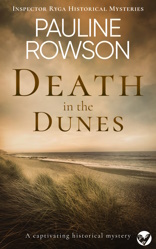
Most of my crime novels and thrillers are contemporary but some years ago I decided to pen an historical crime fiction novel. It was something I had been wanting to write for some time, in fact it started many years ago and could be said to be my original intention.
When I first started writing novels way back in the late 1980s I wrote historical sagas, set in South Wales, the home of my father. As I wrote more of them a criminal element kept creeping into the story line. None of those novels have ever been published and after many rejections I turned to writing contemporary crime fiction. It made sense because, after all, I'm an avid crime fiction fan.
After publication of the DI Andy Horton Solent Murder Mysteries (now 17) the Art Marvik mystery thrillers (now 4) and two standalone thrillers I thought it about time I looked at penning that historical crime novel.
I chose the starting point for the novels as 1950 because it is a fascinating time. An era caught between the aftermath of the war and the beginning of the cultural and social revolution of the ‘swinging sixties’. Memories of the war are very strong, and the fear of more world conflicts haunt people. The Korean War is in progress and National Service has been extended. All around is the legacy of the war with bombsites and rubble, bombed out buildings and houses, abandoned military bases in the country and overgrown pillboxes and batteries littering the coast.
With the housing shortages caused by the bombing many are living in privately rented dinghy cramped bedsits and poor quality houses with little privacy, comfort and warmth. Or in prefabs, railway carriages, houseboats, or huts. The housing boom and erection of new towns and cities has yet to materialise.
Rationing of some goods is still in operation. There are severe shortages of many consumer products, ‘make-do-and-mend’ carries on, as does the black market.
And there are many fractured lives – widows and widowers, mothers and fathers who have lost sons and daughters, people maimed and scarred both physically and emotionally. Others, who, after experiencing the adrenaline rush of combat and a varied and exciting life, are finding it hard to adjust, some seek ways to cope through alcohol, crime, and substance abuse.
Many women who worked in the war are now back at home, some pleased to be, others very much less so. They’re not expected to have careers, but jobs to tide them over before they marry and have children.
After the war came the nationalisation of the coal mines, the railways, the Bank of England and the iron and steel industry. The creation of the free National Health Service improved the quality of medical care, especially for the elderly, women and the poor.
Abortions are illegal, so back street practitioners flourish. There is a social stigma attached to illegitimacy. Divorce is not acceptable in many circles. Homosexuality is illegal. Capital punishment is still in operation.
Policing in the 1950s is also vastly different, no mobile phones, no dashing about in fast cars, and no computers, so it is extremely interesting to research and write from both the social and the police point of view.
The 1950s then is an interesting and fascinating era to set down my new detective, Inspector Alun Ryga who is sent out from Scotland Yard to investigate coastal crimes. Ryga's experience at sea, as a former merchant seaman, and his ordeal as a German prisoner-of-war, has made him unique in his approach to solving crimes. He's observant, analytical and reflective. He's witnessed compassion, cruelty, cowardice and heroism, mental breakdown and despair. He’s made a promise to himself that whatever happens after the war he’ll keep an open mind and never judge.
DEATH IN THE COVE (1) introduces Inspector Ryga when he is sent to the Royal Island of Portland, Dorset. His second case, DEATH IN THE HARBOUR, is set in the port of Newhaven, East Sussex; his third,DEATH IN THE NETS in the fishing port of Brixham and his fourth DEATH IN THE DUNES in Dungeness and New Romney, Kent. Number five in the series is to be published in June 2024 and sees Ryga on a complex case in Cornwall. I hope you enjoy reading them.
Pauline Rowson lives on the South Coast of England and is the best selling author of many crime novels, published by Joffe Books. Her popular crime novels include the DI Andy Horton Solent Murder Mystery series, the Art Marvik mystery thrillers and the 1950s set Inspector Ryga mysteries. Subscribe to her newsletter for all the latest books news.